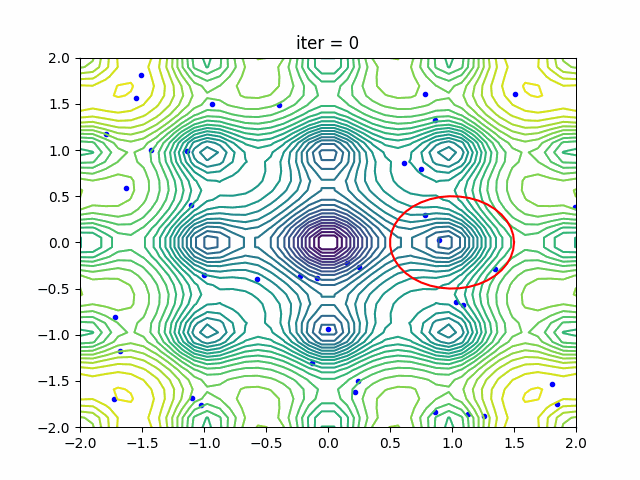使用scikit-opt中粒子群算法求解函数优化问题
一、有约束情况下的粒子群算法函数寻优思想
粒子群算法求解约束优化问题,关键是约束的处理,初始化将粒子历史最优位置设为 + ∞ +\infty +∞,每次迭代若粒子位置满足约束且优于历史最优位置,则更新位置,逐步引导粒子在可行域内搜索最优解。
或者采用罚函数法、增广拉格朗日函数法将约束优化问题转化为无约束优化问题后,可以采用梯度类、粒子群算法进行求解。https://blog.csdn.net/qq_43276566/article/details/136810660
二、官网例题求解
scikit-opt库中,从sko.PSO中导入PSO算法,可以用来求解不等式约束优化问题(目前还不能求解等式约束优化问题),官网例题如下:
min
f
(
x
1
,
x
2
)
=
−
20
×
e
−
0.2
0.5
(
x
1
2
+
x
2
2
)
−
e
0.5
(
cos
2
π
x
1
+
(
cos
2
π
x
2
)
)
+
20
+
e
s.t.
(
x
1
−
1
)
2
+
x
2
2
−
0.
5
2
≤
0
x
1
,
x
2
∈
[
−
2
,
2
]
\begin{align} \min & \quad f(x_1, x_2) = -20 \times \text{e}^{-0.2\sqrt{0.5(x_1^2+ x_2^2)}} -\text{e}^{0.5 (\cos 2 \pi x_1 + (\cos 2 \pi x_2))}+20+ \text e \\ \text{s.t.} & \quad (x_1-1)^2 + x_2^2 - 0.5^2 \leq 0 \\ & \quad x_1,x_2 \in [-2,2] \end{align}
mins.t.f(x1,x2)=−20×e−0.20.5(x12+x22)−e0.5(cos2πx1+(cos2πx2))+20+e(x1−1)2+x22−0.52≤0x1,x2∈[−2,2]
该问题的最优解为
f
(
0.95
,
0
)
=
2.58
f(0.95,0)=2.58
f(0.95,0)=2.58
官网代码如下:
import numpy as np
import matplotlib.pyplot as plt
from matplotlib.animation import FuncAnimation
from sko.PSO import PSO
def demo_func(x):
x1, x2 = x
return -20 * np.exp(-0.2 * np.sqrt(0.5 * (x1 ** 2 + x2 ** 2))) - np.exp(
0.5 * (np.cos(2 * np.pi * x1) + np.cos(2 * np.pi * x2))) + 20 + np.e
constraint_ueq = (
lambda x: (x[0] - 1) ** 2 + (x[1] - 0) ** 2 - 0.5 ** 2
,
)
max_iter = 50
pso = PSO(func=demo_func, n_dim=2, pop=40, max_iter=max_iter, lb=[-2, -2], ub=[2, 2]
, constraint_ueq=constraint_ueq, verbose=True)
pso.record_mode = True
pso.run()
print(pso.gbest_y)
print('best_x is ', pso.gbest_x, 'best_y is', pso.gbest_y)
# %% Now Plot the animation
record_value = pso.record_value
X_list, V_list = record_value['X'], record_value['V']
fig, ax = plt.subplots(1, 1)
ax.set_title('title', loc='center')
line = ax.plot([], [], 'b.')
X_grid, Y_grid = np.meshgrid(np.linspace(-2.0, 2.0, 40), np.linspace(-2.0, 2.0, 40))
Z_grid = demo_func((X_grid, Y_grid))
ax.contour(X_grid, Y_grid, Z_grid, 30)
ax.set_xlim(-2, 2)
ax.set_ylim(-2, 2)
t = np.linspace(0, 2 * np.pi, 40)
ax.plot(0.5 * np.cos(t) + 1, 0.5 * np.sin(t), color='r')
plt.ion()
p = plt.show()
def update_scatter(frame):
i, j = frame // 10, frame % 10
ax.set_title('iter = ' + str(i))
X_tmp = X_list[i] + V_list[i] * j / 10.0
plt.setp(line, 'xdata', X_tmp[:, 0], 'ydata', X_tmp[:, 1])
return line
ani = FuncAnimation(fig, update_scatter, blit=True, interval=25, frames=max_iter * 10)
plt.show()
ani.save('pso.gif', writer='pillow')

三、scikit-opt源码复现
scikit-opt有中文文档,并且可以查看源码,遂进行复现:
from matplotlib import cm
from mpl_toolkits.mplot3d import Axes3D
import numpy as np
import matplotlib.pyplot as plt
import matplotlib as mpl
mpl.rcParams['font.sans-serif'] = ['Times New Roman'] # 指定默认字体
mpl.rcParams['axes.unicode_minus'] = False # 解决保存图像是负号'-'显示为方块的问题
class PSO:
def __init__(self, function, constraints, lb, ub):
self.w = 1 # 惯性权重
self.c1 = 0.5 # 加速系数
self.c2 = 0.5 # 加速系数
self.dimension = 2
self.pop_size = 50
self.max_iteration = 100
self.lb = np.array(lb)
self.ub = np.array(ub)
assert np.all(self.ub > self.lb), 'upper-bound must be greater than lower-bound'
self.max_speed = self.ub - self.lb # 限制粒子的最大速度
self.function = function
self.constraints = constraints
def evaluate(self, X):
x = X[:, 0]
y = X[:, 1]
return self.function(x, y).reshape(-1, 1)
def check_constraint(self, x):
# gather all unequal constraint functions
for constraint_func in self.constraints:
if constraint_func(x) > 0:
return False
return True
def update_velocity(self, X, V, pbest, gbest):
"""
根据速度更新公式更新每个粒子的速度
:param V: 粒子当前的速度矩阵,20*2 的矩阵
:param X: 粒子当前的位置矩阵,20*2 的矩阵
:param pbest: 每个粒子历史最优位置,20*2 的矩阵
:param gbest: 种群历史最优位置,1*2 的矩阵
"""
r1 = np.random.random(size=(self.pop_size, self.dimension))
r2 = np.random.random(size=(self.pop_size, self.dimension))
V = self.w * V + self.c1 * r1 * (pbest - X) + self.c2 * r2 * (gbest - X) # 直接对照公式写就好了
return V
def update_position(self, X, V):
X = X + V
X = np.clip(X, self.lb, self.ub)
return X
def update_pbest(self, X):
pass
def run(self):
history = []
# 初始化粒子的位置和速度
X = np.random.uniform(low=self.lb, high=self.ub, size=(self.pop_size, self.dimension))
V = np.random.uniform(low=-self.max_speed, high=self.max_speed, size=(self.pop_size, self.dimension))
pbest_x = X
pbest_y = np.array([[np.inf]] * self.pop_size) # pbest_y = Y 不收敛, 必须设置为无穷大
gbest_x = X[0]
gbest_y = np.inf
for i in range(0, self.max_iteration):
V = self.update_velocity(X, V, pbest_x, gbest_x) # 更新速度
X = self.update_position(X, V) # 更新位置
Y = self.evaluate(X) # 计算目标函数值
# 更新每个粒子的历史最优位置
need_update = Y < pbest_y
# print(need_update[0])
for idx, x in enumerate(X):
if need_update[idx,]:
need_update[idx] = self.check_constraint(x)
pbest_x = np.where(need_update, X, pbest_x)
pbest_y = np.where(need_update, Y, pbest_y)
# 更新群体的最优位置
idx_min = pbest_y.argmin()
if gbest_y > pbest_y[idx_min]:
gbest_x = pbest_x[idx_min, :].copy()
gbest_y = pbest_y[idx_min]
history.append((gbest_x, gbest_y))
x1, x2 = gbest_x
print(f'x1={x1:.2f}, x2={x2:.2f} 全局最小值:{np.around(gbest_y, 3)}')
self.plot_objective_value(history)
def plot_objective_value(self, history):
obj_list = [gbest_y for gbest_x, gbest_y in history]
print(obj_list)
if obj_list[0] == np.inf:
i = None
e = None
for idx, obj in enumerate(obj_list):
if obj != np.inf:
i = idx
e = obj
break
for j in range(i):
obj_list[j] = e
plt.figure(figsize=(5, 4))
plt.plot(np.arange(self.max_iteration), obj_list, color="#191970", linewidth=1.5, alpha=1.)
plt.grid(True)
plt.xlabel("iteration")
plt.ylabel("objective value")
plt.show()
if __name__ == '__main__':
def demo_func(x1, x2):
return -20 * np.exp(-0.2 * np.sqrt(0.5 * (x1 ** 2 + x2 ** 2))) - np.exp(
0.5 * (np.cos(2 * np.pi * x1) + np.cos(2 * np.pi * x2))) + 20 + np.e
constraint_ueq = (
lambda x: (x[0] - 1) ** 2 + (x[1] - 0) ** 2 - 0.5 ** 2
,
)
pso = PSO(function=demo_func,
constraints=constraint_ueq,
lb=[-2, -2],
ub=[2, 2]
)
pso.run()
求解结果为:
x1=0.94, x2=0.01 全局最小值:[2.583]
目标函数收敛图:

参考
- 基于粒子群算法的无约束优化问题求解
- Python主要智能优化算法库汇总
- https://github.com/guofei9987/scikit-opt/blob/master/examples/demo_pso_ani.py
- https://scikit-opt.github.io/scikit-opt/#/zh/README?id=_3-%e7%b2%92%e5%ad%90%e7%be%a4%e7%ae%97%e6%b3%95
- 使用粒子群算法求解约束优化问题






















 1733
1733











 被折叠的 条评论
为什么被折叠?
被折叠的 条评论
为什么被折叠?








